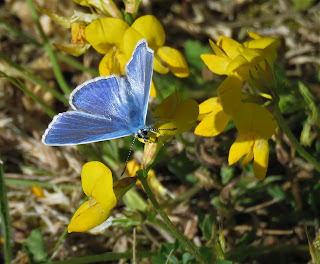It has been a very dry spring this year and the landscape around me looks like it needs some rain desperately. I've been playing around with a new plant ID app on my phone lately called PlantNet. Basically, I take a photo of any plant I see (even trees, ferns and grass) with the camera on my phone, post it on the app and it narrows it down to a possible list with photos of what it could be. Its not perfect and its better to use the scientific name than the English name as the English name might not be one you are familiar with, however this app has been rather handy. I recommend using the result the app gives you as a reference and use a book to double check. I've been using this app as I walk around the streets of Norwich as I make my way to work, its quite addictive.
On Saturday, I took my camera and my phone to my local park to take photos of more plants. There's been a remarkable change since my last visit here. The fields are bursting with the colour yellow as bird's-foot trefoil and buttercups cover the landscape with patches of white ox-eyed daisies and the tufts of various grass species poking out amongst them. There were even a few red heads of poppies bouncing in the light breeze. And to add to the colours of this scene of early summer are common blue butterflies fluttering over to pollinate the trefoil.
What I really was hoping to find though are orchids. I was at least hoping that common twayblades and bee orchids would call this park home. Sadly, my more reliable spots in the city for orchids are now mowed down early for some reason (especially the spot near Carrow Road where I had great success with bee orchids last year). If anyone know of any orchid hotspots in Norwich that I don't know of, let me know. To include orchids to my city plant list would be the cherry on top of the cake.
June 1st Thorpe Marshes
I was back at Thorpe Marshes yesterday looking for even more plants as well as the elusive corncrake that I can gladly say was still at this reserve. He was calling on and off in one corner of the grazing fields during this latest visit. Hidden somewhere deep within dense grass, there really wasn't any chance I was going to see it no matter how long I waited. At least I heard it, though sometimes it took 10-20 minutes until he made another outburst. An amazing sound nonetheless.
 |
| Norfolk Hawker |
The corncrake may have been a no show, but at least the dragonflies weren't afraid to show themselves. There were plenty of them whizzing around the ditches as they competed in fierce aerial battles as they fought for territories. Norfolk hawkers brought a part of Strumpshaw that I've missed so much as I watched them hover in place with big green eyes clearly visible before they rush off to their next fight. I also saw four-spot chasers, hairy dragonflies and banded demoiselles as well as linnets, a kestrel, a buzzard, reed buntings, reed and sedge warblers and few more species to add to my plant list. I think I'm well over 100 species and there's so much more out there that I haven't added yet.

No comments:
Post a Comment